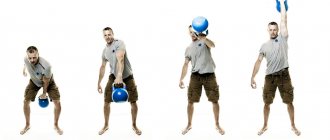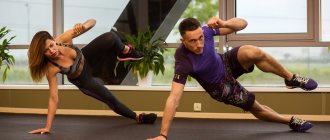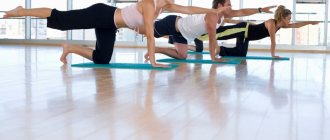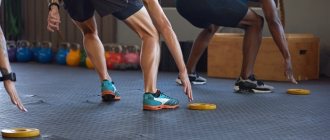Updated June 25, 2020 In the world of CrossFit, athletes are constantly striving to shock their bodies with new types of loads. Unusual exercise regimes or even non-standard training of muscle groups are used. After all, the main goal of an athlete in CrossFit is to develop functional strength that will be useful in everyday life. That is why exercises with a rope have become especially popular. It is important to understand that it is not a simple rope that is used, but a special sports equipment with a weight (usually in the form of a weight) at the end. This way, you can transfer inertia to the end of the projectile due to a strong lever, thereby greatly increasing the load on the target muscle groups.
Are there any contraindications?
Before considering the types and techniques of exercises with a rope, it is worth paying attention to what it involves - and therefore, what contraindications may arise when working with a rope. Since the rope implies a high static load on the back, then:
- you cannot work with a rope if you have problems with the spine;
- with an underdeveloped back muscle corset;
- with insufficiently developed muscles for dynamic loads;
- with injury to the lumbar region;
- in the presence of intervertebral hernias or sprains;
- in the postoperative period;
- with underdeveloped forearms;
- for problems in the abdominal area.
And most importantly, exercises with a rope are prohibited for people with problems with the cardiovascular system. Why? This is due to the fact that it is impossible to regulate the load by the number of times when working with a dynamic process, which means there is a risk of reaching and maintaining the pulse at peak load
Note: on the other hand, people with a high degree of fitness do not have to worry, since with a good vascular system, the pulse will reach the intensity of fat burning. This means that the entire rope complex is good to use for weight loss, without injuring muscles.
Why exercise with ropes in the gym?
Why, in CrossFit, and in other speed-strength sports, exercises with ropes for the arms are increasingly gaining popularity. There are several explanations for this.
- Firstly, dynamic load. When performing classic exercises with a barbell or dumbbells, the arms work in a dynamic phase. That is, they rest and load up. When working with a rope, a micro-superset effect occurs. When exercises with a rope work in one phase of the movement, for example, the biceps, and in another - the triceps. This does not allow the muscles to rest, and supercompensation with stabilization increases isometric muscle performance, due to which athletes greatly increase strength endurance.
- The next point is the presence of isometry in the loads. When working with a rope, the muscles are worked at a very unusual angle, which allows you to engage the deepest muscle fibers without any problems.
- Thirdly, there is a low chance of injury. The main load is regulated by the speed of the exercise, and the maximum complexity is provided not by weight, but by the weakest component of the muscle corset, the wrists. And since the wrists cannot be stronger than the back muscles, it is simply impossible to accelerate the rope more strongly, because in case of critical load it will simply fly out of your hands.
Note: the rope flying out of your hands is fraught with stretching due to sudden movement and the resulting inertia.
CrossFit rope training is gaining popularity
- Benefits of Rope Training
- Cable ropes can be a form of high intensity interval training
- Full Body Cable Workout with 9 Exercises
- If you like ropes, you should also try kettlebells.
Unlike the relatively static movement of raising and lowering a barbell, using cables is a dynamic, constantly changing form of movement that has the added benefit of indicating whether you are performing the exercises correctly.
The ropes can be used as a whip, they can be beaten against each other or pulled, but the most popular is the wave-like movement. In a typical ropes class, teams of people may compete to maintain a wave, or the ropes may be used as part of a high-intensity circuit training session.
Ropes are often thought of as an upper body exercise, which is what they are. However, their advantages do not end there. They work your abs, back, and butt muscles, and you can add movements like jumping, lunges, and squats that work your legs.
Jonathan Ross, spokesperson for the American Council on Exercise (ACE), told News Asia:
Donna Cyrus, senior vice president of programming at Crunch, continued:
Research published in the Journal of Strength and Conditioning Research even found that a 10-minute workout resulted in increased heart rate and energy expenditure, which improved cardiorespiratory exercise test scores.
Ropes are a simple exercise tool that just about anyone can do, so don't be intimidated if you're a beginner. They come in different lengths and widths, depending on the intensity of your workout.
The longer and thicker the rope, the more force you will need to create waves. The permissible attenuation also determines the intensity. The closer to the anchor point, the more resistance you will create.
Three popular uses are described below, but don't stop there. The charm of ropes is that they allow you to move in so many directions. The more movements you do (such as side to side, up and down, or in circles), the more you work different muscles and increase shoulder mobility and range of motion.
- Waves - A variable pattern with the direction of force towards an anchor point.
- Punch - An aggressive movement with force directed down towards the ground.
- Whip - A symmetrical pattern with the main direction of force towards the anchor point.
When working with ropes, there are two types of grip, either from above (handshake) or from below (microphone). The choice depends on the specific exercise and desired results.
High intensity interval training (HIIT) has been shown to be one of the best forms of exercise in terms of both efficiency and productivity. In fact, evidence shows that by focusing on endurance exercises like jogging on a treadmill, you're actually giving up many of the benefits.
When men and women participate in this program for four weeks, they increase VO2 max—the maximum amount of oxygen you can take in during exercise and is used as a measure of cardiovascular health. Cable interval training has been noted to have the potential to improve both aerobic and anaerobic performance in as little as four weeks.
Both the double wave and alternating wave are beginner moves, so it's a simple and effective workout to get you started with the ropes. Here are two clear descriptions of how to do them:
Fitness expert Jonathan Ross developed this full-body cable workout. It begins with a warm-up with lateral lunges in place with a variable wave and lunges with a twist and throwing ropes over the head. After you've warmed up, nine different exercises follow. You can read their descriptions in the table below, which was published by ACE.
If you like simple training tools that can be used in a variety of ways, such as ropes, you'll probably enjoy using kettlebells, which consist of a cast iron ball and handle and exercises with them involve movements that shift your center of gravity, forcing you to use several muscle groups, including the core, to maintain balance.
Kettlebell exercises not only help improve your aerobic capacity, it is also an anaerobic workout that is important for cardiovascular health, as well as improving strength, speed and muscle mass.
Similar to cables, kettlebells are dynamic full-body exercises that work the cardiovascular system, incorporate resistance and develop range of motion. Regular use of both tools will help you target different muscle groups while keeping your workout fun.
For optimal health and tone, I recommend performing a variety of exercises, paying close attention to daily movement outside of exercise. Ideally, you want to remain active and standing for most of the day, so that sitting interrupts your activity, rather than the other way around. A well-planned fitness program usually includes the following:
1. Sit as little as possible
Research is clear: the more you sit, the greater the health risks. And this is true even if you exercise regularly and keep yourself in shape! The main thing is to move all day long. To understand how to do this on a regular basis, watch my interview with Dr. James Levine, author of Get Up!: Why Your Poop is Killing You and What You Can Do About It.
In addition to limiting your sitting time as much as possible, I also recommend challenging yourself to walk 7,000-10,000 steps per day in addition to your regular fitness program and standing while working. Consider purchasing a new fitness tracker that can monitor your steps and sleep, and help you keep track of your daily movements.
2. High Intensity Interval Training (HIIT)
As mentioned, it involves alternating short bouts of high-intensity exercise with periods of recovery.
3. Core exercises
There are 29 core muscles in your body, located primarily in the back, abdomen, and pelvis. This muscle group provides the foundation for movement throughout the body, and strengthening it can protect and support your back, make your spine and body less prone to injury, and help you develop balance and poise.
4. Stretching
My favorite type is the active isolated stretch developed by Aaron Matt. With them, you stretch each area for two seconds, which works with your body's natural physiological makeup to improve circulation and increase elasticity in muscles and joints. This method also allows your body to recover and prepare for everyday activities.
5. Strength training
Completing the program with one set of strength training will ensure that you are truly optimizing the possible health benefits. You can also turn it into a high-intensity exercise by decelerating, you can learn more about this in my interview with Dr. Doug McGuff. Published by econet.ru.
Did you like the article? Write your opinion in the comments. Subscribe to our FB:
The world of CrossFit is a real treasure trove of a wide variety of exercises. Athletes, striving for constant growth and progress, come up with non-standard methods of working out muscle groups. One of them is rope exercises. CrossFit training using this equipment is very popular and not in vain.
In CrossFit, you will be asked to work not with a regular rope, but with a special sports equipment with a weight at the end. Thus, the target muscle groups are subjected to an intense load, achieved by transferring inertia to the end of the projectile.
Exercises
What rope exercises are there?
- alternating waves in a half-squat;
- double wave;
- jumping with powerful claps;
- rotation from side to side;
- standing rope release;
- jumping with alternating waves;
- running in place;
- throwing yourself while sitting;
- plank with wave;
- side plank with rope.
Let's take a closer look at which muscle groups are involved in this or that exercise with a rope.
| Exercise | Muscle group | |
| Double wave | Upper shoulder girdle | |
| Jumping with powerful claps | Leg and abdominal muscles | |
| Rotation from side to side | Lateral abdominal muscles. | |
| Standing rope throw | Upper shoulder girdle | |
| Jumping with alternating waves | Leg muscles | Run |
| on the spot | Legs + heart | |
| Throws while sitting | Legs + body and core | |
| Plank with wave | Core+ press | |
| Side plank with rope | Core+ press | |
| Alternating waves in a half-squat | Upper shoulder girdle |
Exercise "Waves"
Waves are usually what you see on YouTube in commercials. The most challenging aspect of the wave series is the zero downtime when doing the exercises correctly. Waves require 100% commitment.
There are different variations of these exercises, including different intervals for specific times and/or distances. Time, distance, number of repetitions - you can constantly change different indicators for different workouts and goals.
When trying to do a wave series for the first time, 20 seconds will seem like an eternity, but with regular training, people adapt quickly and can maintain a constant pace and intensity from 5 minutes to over 45 minutes. As a recommendation: build up to 10-20 minutes, and then work up the intensity and speed.
A series of waves is performed in a plank position, standing, kneeling, sitting. As you move from standing to kneeling, it becomes increasingly difficult to complete the waves. Adding different movements (squats, lunges, jumps, lateral movements and more) can make a basic movement very difficult.
The faster you progress, the harder and more intense the workout becomes. Try to maintain a pace of 120-150 alternating waves per minute and listen to how you feel.
How to do?
Despite its apparent simplicity, many rope exercises in the gym require special technique. The general principles for all exercises are the same:
- Do not use safety straps. The load should be limited to maximum wrist strength.
- Work at a moderate speed, increasing the load gradually as muscle mass increases.
- Combine with statodynamic exercises.
- Use basic pre-fatigue exercises before working with a rope.
- Work in pairs with a partner who will control the correct technique of performing the exercises.
- Use a heart rate monitor throughout your rope set. If your heart rate exceeds the permissible rate, stop and take a break.
Note: the maximum allowable heart rate is calculated using a simple formula (220-age) * 80%. Upon reaching this pulse, you need to immediately reduce the intensity of the exercise, since the athlete runs the risk of getting microtraumas to the heart, which will be overgrown with connective tissue, and thereby lead to sports heart disease.
Alternating waves in a half-squat
- Take two ropes of extremely large thickness (so that it is impossible to close your fingers around the diameter).
- Get into a half squat.
- Bend your lower back.
- Stretch your arms in front of you, not fully extending them at the elbow joint.
- Slowly start moving your right hand up and your left hand down.
- Gradually speed up your movements.
- At the end of the rope, make a sharp jerk to compensate for inertia.
Work until there is a strong pump or until the pulse reaches a critical level.
Double wave
This is a complicated version of the previous exercise, which requires more concentration, loads not only the upper shoulder girdle, but also the abdominal muscles, due to the need to dampen the inertia of the rope.
- Take two ropes of extremely large thickness (so that it is impossible to close your fingers around the diameter).
- Get into a half squat.
- Bend your lower back.
- Stretch your arms in front of you, not fully extending them at the elbow joint.
- Slowly start moving your hands down and then up.
- Gradually speed up your movements.
- At the end of the rope, make a sharp jerk to compensate for inertia.
Jumping with powerful claps
This exercise is somewhat more complicated, but it uses the leg muscles to their full potential, which can even replace a squat with a barbell.
- Take the ropes in your hands.
- Get into a half squat.
- Bend your lower back.
- Stretch your arms in front of you, not fully extending them at the elbow joint.
- After this, jump sharply up.
- At the same time, raise the ropes as high as possible above your head.
- At the moment of peak inertia, which coincides with the landing, make a “whip” movement, sharply lowering the ropes down.
If the ropes do not fly out of your hands, you can repeat. Work until the pulse is felt, or until the wrist muscles are severely weakened.
Rotation from side to side
- Take two ropes in your hands.
- Make a slight bend in the lower back, while keeping your back generally relaxed.
- Relaxing your lower back, begin to pull the ropes towards your belt (with an intense movement), while simultaneously turning your body in the direction of movement.
- At the peak of the load, turn in the other direction to achieve optimal results.
Repeat until completely exhausted.
Standing rope throw
The technique of a standing rope throw resembles a double wave. The main difference lies solely in the working amplitude. Instead of working in a half-squat, you need to work with a jump, while throwing the rope forward as much as possible (by moving your arms up). Otherwise, everything is identical.
Jumping with alternating waves
Variable wave jumps are performed as follows:
- Two ropes are taken;
- The starting position is taken from a full squat;
- Gradually, the movement begins with one hand down, the other up;
- Subsequently, a deep squat jump is performed;
- In this case, the wave movements do not stop, but only accelerate.
The ideal option is when there are no more than two cycles of wave movements of the arms per jump. The abdominal muscles, muscles of the upper shoulder girdle, back, pectoral and deltoids are worked out.
Learning to climb a rope: exercise 5
The last exercise is an isometric exercise that controls the widest muscles of the back. You can do it in a sitting or standing position. Bend your elbows and grasp the rope with your palms close to each other. The exercise is based on tightly grasping the rope and pulling your arms up, trying to connect them. Squeezing the rope should take a few seconds, and then you need to relax the muscles. Repeat the exercise at least 5 times.
014
EcoFit.info
Upper body and core exercise
These are the same exercises with a rope for classic crossfit, the emphasis in which is not on the hands at all, but on working with a partner and correct body movements.
Throws while sitting
The exercise is similar to working with turns. The main difference is the isolation of the abdominal and core muscles, which is achieved by turning off the muscles of the legs and lower back, which eat up the lion's share of the load.
- Sit on the floor;
- Take 2 ropes in your hands;
- Make wave movements, while trying to pull the ropes to the belt;
- At the moment of attraction, gradually turn the body;
- At the peak of the load from the rope, turn in the other direction.
Plank with wave
The wave plank is a rather pointless exercise in terms of difficulty/effectiveness, but many lovers of handstands in the prone position love it because it allows you to develop the core muscles, much more effectively than a vacuum.
How to do it correctly:
- Get into the plank position on one arm (the hand should rest not on the floor, but on a special stand);
- The second hand should hold the rope;
- Slowly begin to make a wave movement from side to side, gradually accelerating.
Work until the heart rate monitor reaches a critical point.
Side plank with rope
This is a very simple exercise for those who have mastered the side plank.
- Get into a side plank position with the main weight resting on your elbow;
- Maintain deflection;
- In the other hand, take the rope by the tip;
- And slowly - by turning your body back and moving your shoulder blades, move the rope towards you.
It is important to do this not with your arms (biceps muscles), but with your back and body.
- When you reach the end of the rope, turn to the other hand and continue the exercise.
The main feature is cyclicality, and high involvement of the rhomboid muscles of the back and oblique abdominal muscles. The movement occurs solely due to traction with the elbow (not the wrist), which allows you to completely disable the shoulders.
Bottom line
As can be seen from all of the above, exercises with a rope can replace almost the entire gym equipment. After all, during work, both the muscles of the legs and abs, as well as the muscles of the back and upper shoulder girdle are involved. The ability to constantly increase the load without risking injury makes the exercises most effective for all groups of athletes, both beginners and experienced athletes.
And most importantly, eliminating inertia in most exercises allows you to work not only on strength and endurance, but also on explosive characteristics. It is due to the explosive elements that the muscles are worked as deeply as possible (after all, about 80% of the muscle fibers are involved), and with the correct load, exclusively lean muscle mass grows, with a high ability to recover. Therefore, rope exercises are highly recommended for those athletes who engage in impact sports. Working with a rope allows you to increase the impact force up to 7 times in 2 months of training.










